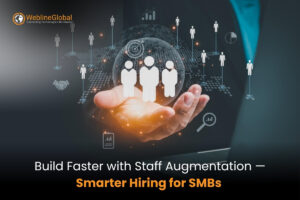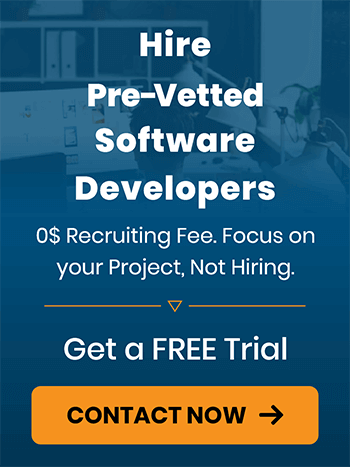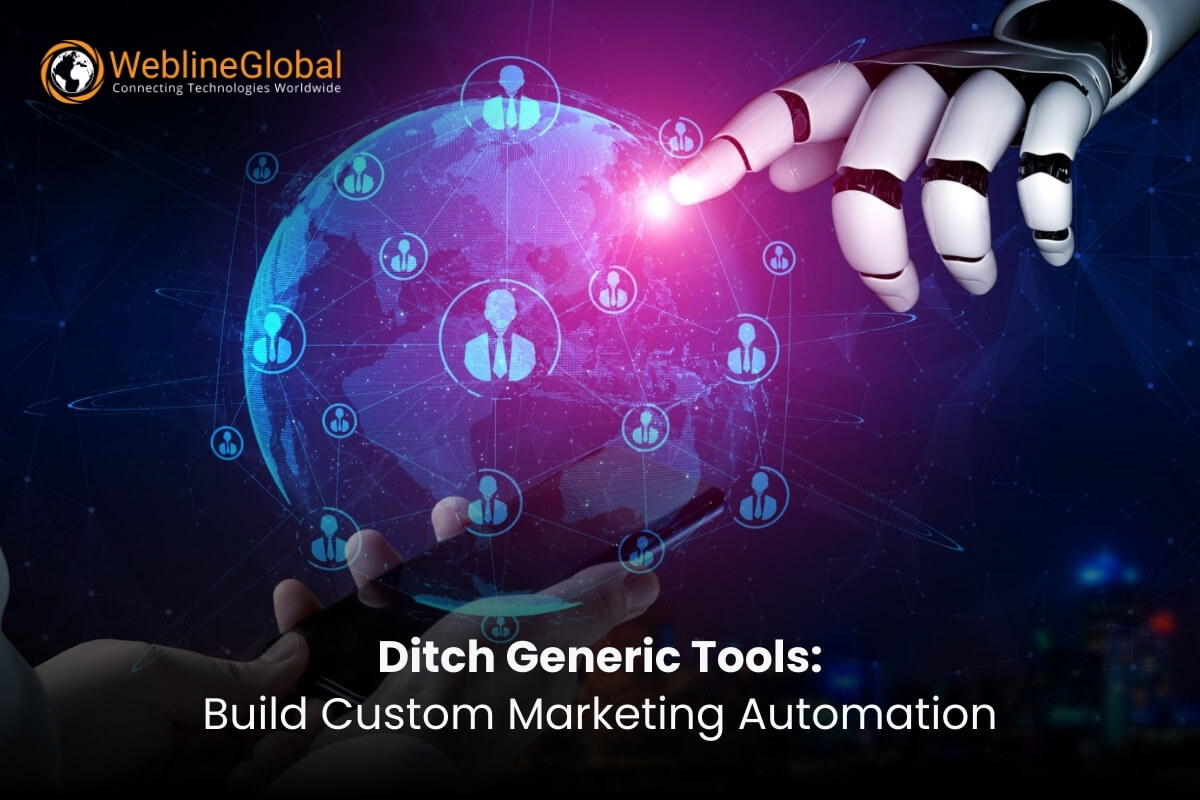
Marketing used to be simpler. Blast an email, run a few ads, maybe post something on social media and you’re in the game. But now? You’re juggling ten tools, six channels and endless data streams, all while trying to keep up with buyers who expect personalized, instant experiences.
That’s why marketing automation took off. Tools like HubSpot, Mailchimp, and ActiveCampaign made it easier to run campaigns without manually hitting “send” every day. But even those platforms come with strings attached: templates, limits and processes you’ve got to mold yourself around. This is where custom software development flips the script. Instead of adjusting your business to fit the tool, you build tools that match how your marketing actually works.
In this article, we’re diving into how custom marketing automation software isn’t just another shiny toy — it’s reshaping how brands approach promotions, campaigns, customer journeys, and conversions.
Tired of juggling tools? Let’s build marketing automation that works your way.
What is Marketing Automation?
The essence of business automation lies in creating automated workflows and processes for any company, for any department or task. For marketing automation, it is self-running campaigns that trigger specific messages and actions based on schedules or user behavior.
Common applications include:
- Automating welcome sequences for new subscribers
- Retargeting leads who abandoned carts or forms
- Delivering educational content through timed drip campaigns
- Smart audience grouping by engagement patterns
- Prioritizing leads through activity-based scoring
The tech stack combines email services, CRM systems, and analytics tools into cohesive sales pipelines. Industry leaders (HubSpot, Marketo, Klaviyo) offer solid out-of-the-box solutions, but their one-size-fits-all approach often forces businesses to conform to preset workflows rather than adapting to unique operational needs.
When your requirements don’t align with their templates? You’ll likely hit customization roadblocks.
Where Off-the-Shelf Tools Fall Short And Why It Matters
Let’s be real — these platforms are solid until you outgrow them. Here’s where things usually fall apart:
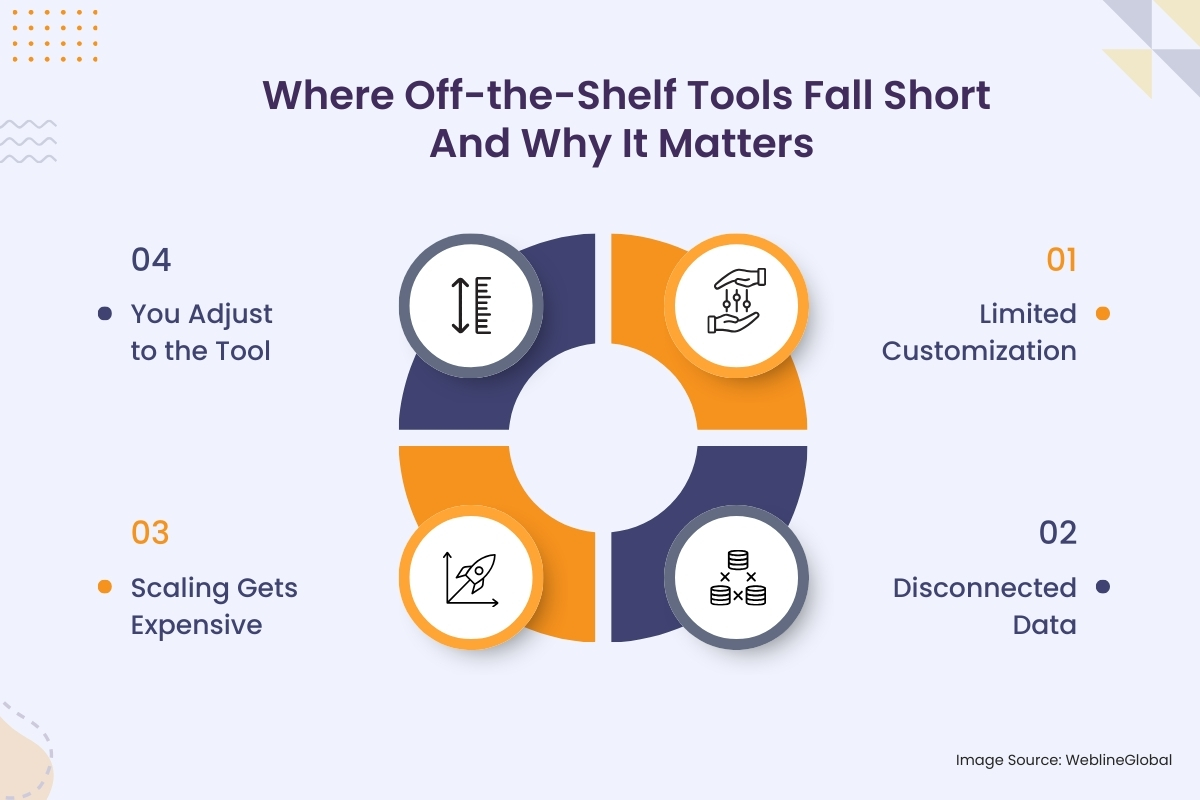
Limited Customization
Trying to build a very specific lead nurturing flow? Or want to segment based on a custom data field that doesn’t exist in your SaaS tool? Good luck. Most platforms are rigid. You get what they give.
Disconnected Data
You’ve got data in your CRM, your product, your email system, and your analytics tool. Off-the-shelf platforms rarely pull everything together cleanly. The result? Your customer view is fragmented.
Scaling Gets Expensive
As your team grows and campaigns get more complex, pricing shoots up. Most tools charge per contact, per user, per email, or all three. Suddenly that “affordable” platform is burning your budget every month.
You Adjust to the Tool
The biggest one? These platforms force you to shape your campaigns and processes around how they think you should market. Not how you actually do it.
That’s backwards. Marketing should move at your speed, not your software’s limitations.
What Makes Custom Marketing Automation Software Different?
Unlike off-the-shelf solutions, custom marketing automation isn’t about predefined features—it’s about crafting tools that perfectly match your team’s unique processes. Here’s why it stands out:
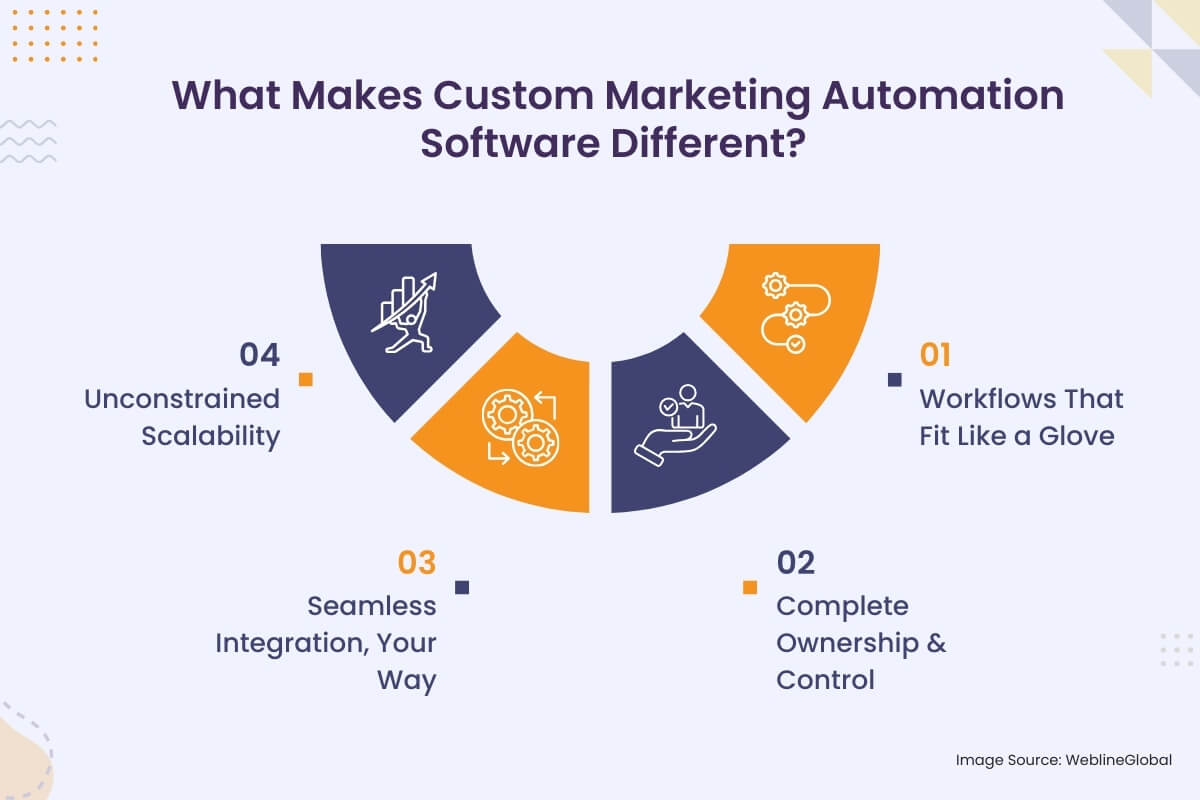
Workflows That Fit Like a Glove
Off-the-shelf tools struggle with complex requirements like multi-source lead scoring (combining website activity, CRM data, and in-app behavior). Custom solutions adapt to your sales cycle—whether it’s days or months—without compromises.
Complete Ownership & Control
Say goodbye to vendor lock-in, per-user fees, and data restrictions. With custom software, you dictate the rules—data storage, access permissions, and tracking parameters are all yours to configure.
Seamless Integration, Your Way
A custom system bridges all your platforms (ERP, CRM, payment processors, eCommerce stores) into unified campaigns, using real-time syncs or automated processes—no data silos left behind.
Unconstrained Scalability
Execute 10K personalized emails hourly? Test 15 campaign variations simultaneously? Custom infrastructure removes artificial limits, letting your team operate at the scale you need.
Beyond automation, custom solutions empower marketers with the agility to innovate and execute bold strategies without technical barriers.
Is your marketing stack holding you back? We’ll tailor the right-fit solution for your goals.
Core Benefits of Custom Software in Marketing & Promotions
Let’s break it down by real-world value. Here’s where custom tools shine:
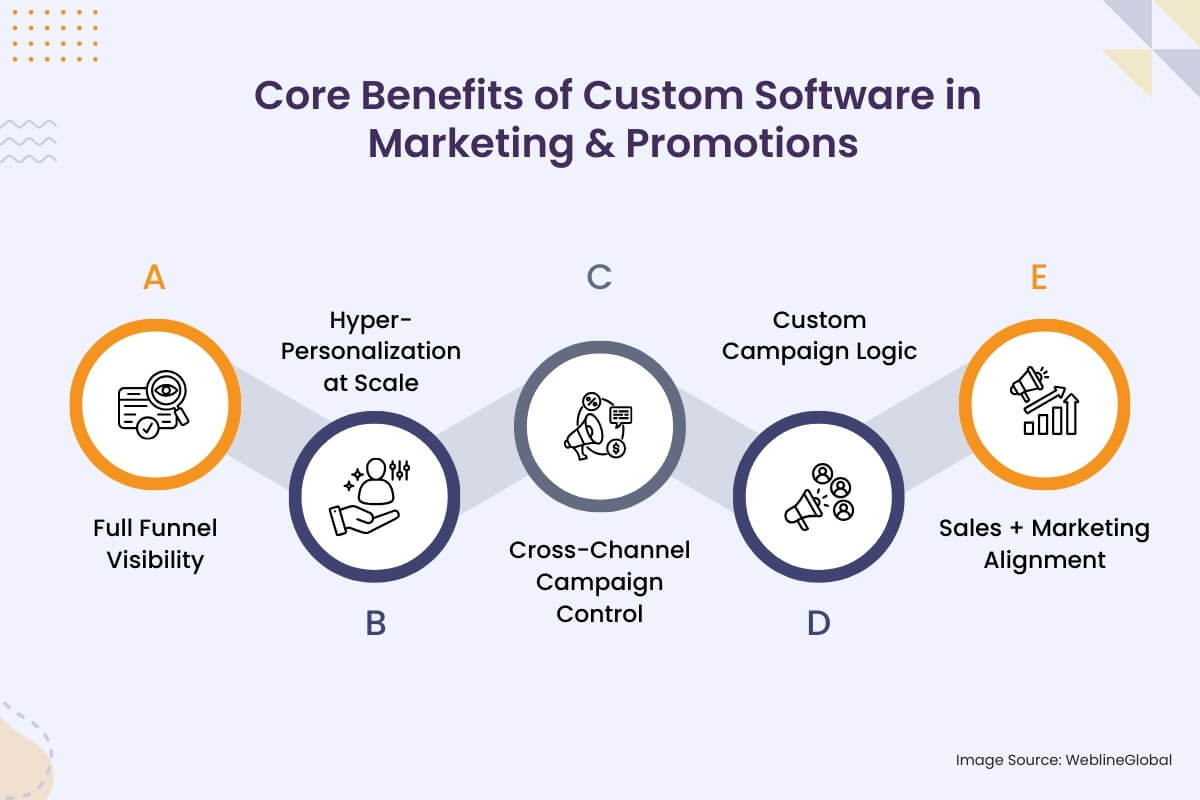
A. Full Funnel Visibility
Most off-the-shelf tools stop at the campaign level. Custom software can give you dashboards showing performance across ads, email, website behavior, product usage, even support tickets.
Want to know exactly where leads are dropping off? Or what campaign touchpoints drive the highest LTV? You’ll see it all, in real time, the way you want it.
B. Hyper-Personalization at Scale
Forget basic “Hey [First Name]” emails. A custom platform lets you create segments and messages based on customer behavior, purchase history, geography, funnel stage, and more.
- You can build logic like: “If user is in California, bought product X, and hasn’t logged in for 14 days → send offer with geo-targeted bonus.”
That’s not theoretical. It’s exactly what smart marketers are already doing with custom logic.
C. Cross-Channel Campaign Control
Instead of setting up emails in one tool, SMS in another, and push notifications in a third — you can manage everything from one interface.
- One campaign, one brain behind it. Emails go out at 9 AM, SMS at noon, push reminder 24 hours later — based on how each user reacts.
D. Custom Campaign Logic
You’re no longer restricted to “if this, then that.” You can build complex, business-specific flows like:
- “If lead watched 50% of webinar, visited pricing page, and didn’t book a demo → trigger personalized follow-up campaign with social proof.”
That level of logic just isn’t possible in most SaaS tools without a dozen plugins or hacks.
E. Sales + Marketing Alignment
Custom marketing software can plug directly into your CRM and product data. That means when a lead hits a certain score, your sales team knows immediately.
Better timing, fewer dropped leads, and higher conversion — all without Slack pings and manual updates.
Industry Use Cases: How Custom Automation Fits Specific Businesses
Now let’s get practical. Different industries = different needs. Here’s how custom software adapts:
A. Retail & eCommerce
- Automate promotions based on inventory levels
- Abandoned cart flows tied to customer lifetime value
- Personalized discount codes that expire dynamically
- Loyalty points tracking + referral programs
Why it works: You’re not running a generic store, so don’t use a generic tool.
B. SaaS Companies
- Trial users get onboarding emails based on in-app behavior
- Churn risk gets flagged automatically
- Marketing emails adjust based on feature usage
- Feedback loops from support tools trigger nurture campaigns
Why it works: Your product is your marketing. A custom engine makes that connection real.
C. Healthcare & Education
- Appointment or class reminders with compliance built-in
- Localized messaging for different states or regions
- Secure data handling across touchpoints
- Lifecycle communication (e.g. follow-ups, renewals, feedback surveys)
Why it works: Off-the-shelf tools struggle with privacy rules, custom fields, and complex timelines.
Custom vs SaaS: Where the Features Really Split
Let’s not sugarcoat it! SaaS tools are great for getting started fast. But once your campaigns grow more advanced or your team needs more control, cracks start to show.
Here’s a no-fluff comparison:
| Feature | SaaS Tools | Custom Software |
| Workflow Flexibility | Limited to what the platform supports | 100% customizable logic |
| Data Ownership | Stored with the provider | Fully yours |
| Integration Options | API access (if available) | Deep custom integration with any system |
| Pricing Model | Subscription, per-contact/user | One-time build + maintenance |
| Campaign Logic | Template-driven | Business-specific logic |
| Personalization | Basic (name, location) | Advanced (behavior, history, segments) |
| Reporting | Pre-built dashboards | Tailored reports, real-time metrics |
| Scaling | Often gated by pricing tiers | Scale based on infrastructure, not license size |
Bottom line: SaaS is fine if you’re okay playing within the sandbox. Custom software builds the sandbox around your rules.
Built-In Features in Marketing Automation Software You Can’t Get Out of the Box
Most marketers never experience true marketing flexibility when confined to off-the-shelf solutions. Here’s what you’ve been missing:
Truly Custom Campaign Logic
- Design your own triggers, actions, and segments with a visual builder
- Implement your unique sales process exactly as you envision it
Intelligent Audience Segmentation
- Create hyper-specific segments like:
- Webinar attendees from past 30 days
- Who viewed pricing page twice
- But haven’t been contacted by sales
- All in a few clicks – no workarounds needed
Precision Timing Engine
- Send each message at the recipient’s optimal time
- Move beyond generic “batch-and-blast” scheduling
Multi-Brand/Multi-Region Control
- Manage multiple brands/languages from one dashboard
- Automatically apply the right assets and rules for each market
Built-In Compliance Safeguards
- Add legal/sales approval steps to any campaign
- Ensure nothing goes live without proper review
These aren’t just features – they’re competitive advantages that only custom automation provides. No more fighting your tools – now they work exactly how you need them to.
Common Myths About Custom Marketing Software Debunked
Let’s clear the air. A lot of people skip custom because of stuff they’ve heard… or assumed. Here’s the truth.
- It’s too expensive: Sure, upfront investment is higher than SaaS. But over 12–18 months, most brands save money. No per-user fees. No scaling costs. No feature gatekeeping.
- It takes forever to build: Wrong. Most MVPs for marketing automation can be rolled out in 6 to 10 weeks. You don’t need every feature on day one — you scale smart, not big.
- We’re too small for this: You’re not. If your marketing needs go beyond basic templates or you’re using 3+ tools just to launch a campaign, you’re already spending more in time and complexity than you’d spend building your own engine.
- We’ll lose support without a SaaS vendor: With the right partner, you get better support. You have someone who knows your logic, your goals, and your stack, not a helpdesk that sends canned responses.
The Indication
While off-the-shelf solutions work for many businesses, there are clear signs when it’s time to upgrade to custom-built automation. If any of these scenarios sound familiar, your business has outgrown generic SaaS tools:
You’re Constrained by Platform Limitations
- You’re modifying your marketing strategy to fit tool capabilities rather than business needs
- Workarounds and compromises have become standard practice
- Key features you need simply don’t exist in current solutions
You’re Drowning in Disconnected Data
- Customer information is trapped across multiple systems (CRM, CMS, support software, etc.)
- You’re manually stitching together data from 5+ sources for basic campaigns
- Important insights slip through the cracks because systems don’t communicate
Personalization” Means More Than Just Names
You need true 1:1 messaging based on:
- Real-time behavior
- Purchase history
- Lifecycle stage
- Geographic location
- Engagement patterns
Your SaaS Costs Are Spiraling Out of Control
- You’re paying for unused features or excessive contact limits
- Each new team member adds significant recurring costs
- Pricing tiers force you into bloated plans for one needed feature
Manual Processes Are Eating Your Productivity
Teams waste hours weekly on:
- Data exports/imports
- Spreadsheet manipulations
- Repetitive campaign setups
- Manual lead scoring
You’re Losing Competitive Advantage
- Competitors with custom solutions move faster and personalize better
- Your marketing feels generic compared to industry leaders
- Innovation is stifled by tool limitations
Compliance and Security Requirements Demand It
- You operate in regulated industries with strict data handling rules
- Need custom approval workflows and audit trails
- Require data residency in specific locations
You’re Preparing for Scale
- Anticipating 10X growth in customer base or campaign volume
- Planning international expansion with regional variations
- Adding new products/services that need distinct marketing flows
Role-Based Value: Who Gets What Out of a Custom Stack
Custom marketing automation isn’t just a “marketing thing.” It impacts multiple roles across the company. Here’s how different teams win:
| Role | What They Get from Going Custom |
| CMO / VP Marketing | Real-time insights, full control over campaign performance |
| Marketing Manager | Faster campaign deployment, smarter workflows |
| Sales Team | Higher-quality leads, synced outreach, fewer missed handoffs |
| Product Team | Data-driven insights tied to feature usage or product behavior |
| Dev / Tech Lead | Clean integrations, stable systems, fewer workarounds |
Integration Capabilities with Custom Marketing Automation Platforms
One of the biggest wins? You’re not stuck hoping your tool has an “integration” that’s really just a third-party connector.
Custom-built marketing software can plug directly into your entire ecosystem:
CRM Systems
- Salesforce, HubSpot, Zoho, Freshsales
- Custom lead scoring, lifecycle sync, and contact updates
eCommerce Platforms
- Shopify, WooCommerce, Magento
- Trigger promotions, reminders, and up-sells based on real-time shopping behavior
Payment & Billing
- Stripe, Razorpay, PayPal, Braintree
- Campaigns based on failed payments, renewals, or LTV milestones
Product Usage & Analytics
- Mixpanel, GA4, Segment, Snowflake
- Auto-trigger onboarding flows, retention campaigns, or feature education
Messaging APIs
- Twilio, Firebase, OneSignal
- Coordinate email, SMS, push, and in-app notifications
Workflow Automation
- n8n, Make (Integromat), Zapier (for fallback flows)
- Build complex event-based automations across your entire stack
With custom software, your tools talk to each other the way you want, not the way some SaaS vendor decided.
Implementation: How to Build Marketing Automation Software Without the Headache
You don’t need to go from zero to Salesforce overnight. Building custom marketing automation software can be lean, fast, and strategic — if you approach it right.
Here’s the breakdown:
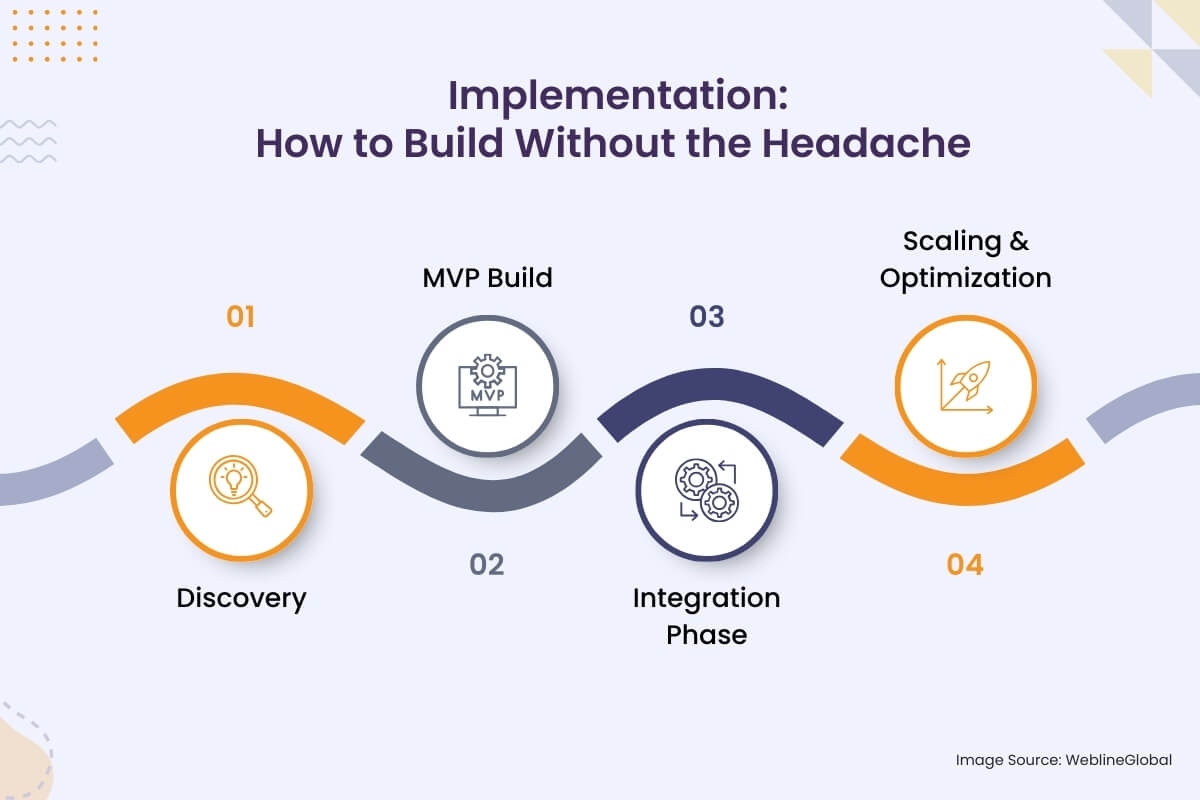
Step 1: Discovery
Start by mapping your current tools, pain points, and goals. Ask yourself: What campaigns are working? Where are your team bottlenecks? What’s missing that you’ve had to work around?
Step 2: MVP Build
Don’t aim for a giant platform right away. Pick 1–2 core workflows, like onboarding emails or lead nurturing, and build automation around that first. It’s faster, cheaper, and gives immediate ROI.
Step 3: Integration Phase
Once the core works, start connecting your CRM, product usage data, ad platforms, and more. This is where your system starts becoming smarter than the people using it in a good way.
Step 4: Scaling & Optimization
Now’s the time to add dashboards, smart personalization, dynamic logic, and reporting that your CMO will actually use. You build what your team needs, when they need it, without chasing some generic product roadmap.
Work With a Partner That Gets Marketing
Reputed agencies such as WeblineGlobal offer IT staff augmentation that helps you build marketing solutions through custom software development. You bring the ideas; the agency helps make the system that runs them.
Long-Term Gains of Going Custom
Sure, it’s more upfront than a SaaS subscription. But let’s look beyond the next billing cycle:
- Cost Control: No per-user or per-email fees. You own it. As your business grows, your costs don’t spiral out of control.
- Competitive Edge: You’re not running the same flows as every other company using the same tool. Your campaigns become uniquely yours — and harder to copy.
- Efficiency Across Teams: Sales gets better leads. Marketing gets faster deployment. Ops sees cleaner data. Everyone wins.
- Adaptable for the Long Haul: Need to add a new region, product, or business unit? You’re not stuck emailing support for feature requests. Your team — or your dev partner — just builds it in.
Final Takeaway: Own Your Marketing, Don’t Rent It
If your campaigns are starting to feel boxed in, your team is stretched thin, or your growth plans are hitting tool limitations, it’s time to rethink the stack.
Custom marketing automation isn’t about building more software. It’s about building smarter campaigns with better control that actually match how your business works.
Thinking of making the switch? Let’s think of an option on how a renowned IT agency, WeblineGlobal, can help build a custom engine that drives your marketing, not drags it down.
Social Hashtags
#MarketingAutomation #CustomSoftware #MarTech #MarketingStrategy #CampaignManagement #SalesAlignment #CRMIntegration #EmailMarketing #MarketingTools
Ready to stop renting tools and start owning a custom marketing engine built for your growth?
